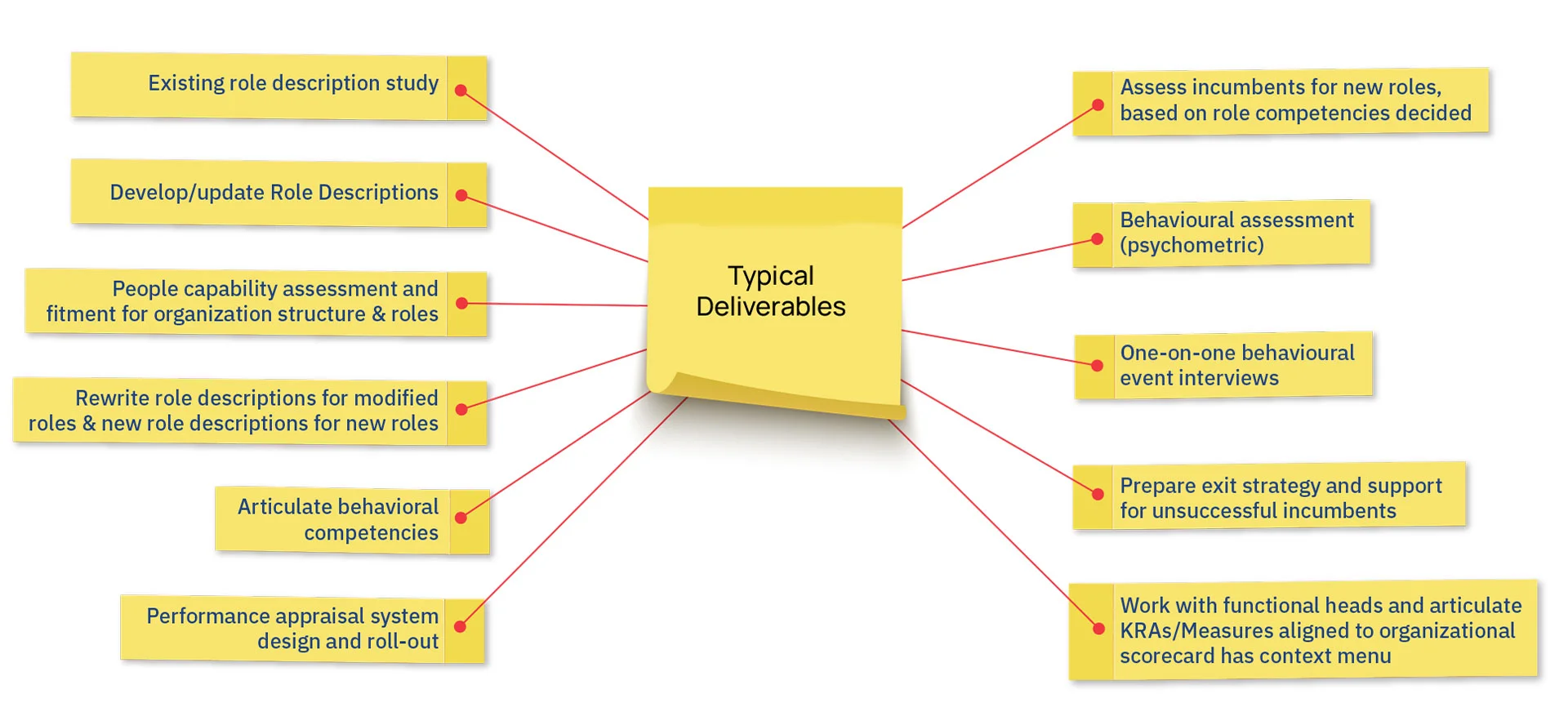Capabilities
Human
Capital
Objective
An organization structure review is crucial for several reasons. It allows an evaluation of the efficiency and effectiveness of the existing structure, identifies areas of improvement, ensures alignment with organizational goals, enhances communication and collaboration, streamlines decision-making processes and facilitates adaptability to changing market conditions. Ultimately, it promotes organizational growth and success.
Typical Deliverables

SSA offers a proprietary 12-step approach to strategy planning that involves envisioning, strategy formation and drill-down to departmental and individual goals and objectives. Over time, as strategies are crystallized, the key challenges that remain are implementation and follow-through. A well-documented strategy is only as good as its implementation. At SSA, we lay particular emphasis on implementation. We achieve this through a meticulous deployment process of linking and cascading strategies down to the grass-root level workforce. This is followed by a rigorous review regime to ensure people stay on course and time and effort are spared for only the most important strategic actions.
Benefits
- Increased Organizational Clarity
A structure review provides an opportunity to redefine roles, responsibilities and reporting lines, which leads to greater clarity within the organization. This clarity helps employees understand their roles and expectations, reducing ambiguity and improving overall performance. - Enhance Employee Engagement
A well-designed organizational structure aligns individual talents and skills with appropriate roles, leading to increased employee satisfaction and engagement. When employees feel their contributions are valued and their roles are well-defined, they are more motivated and committed to achieving organizational objectives. - Improved Decision-Making
A structure review enables the identification and elimination of unnecessary layers of management, promoting faster and more effective decision-making. Streamlining the decision-making process enhances responsiveness, reduces bureaucracy and empowers employees at all levels to make informed decisions, resulting in increased efficiency and agility. - Facilitate Growth and Scalability
As organizations grow, their existing structure may become inadequate. A structure review ensures that the organization’s framework supports future growth, scalability and expansion. It allows for the identification of areas where additional resources, teams or departments may be required, enabling the organization to adapt and thrive in a changing business landscape.
Performance management is a systematic process that organizations use to measure, evaluate, and improve the performance of their employees. It involves setting clear performance expectations, providing feedback, identifying areas for development, and recognizing and rewarding achievements. Performance management helps align individual goals with organizational objectives, ensures accountability, and promotes a culture of continuous improvement. By implementing effective performance management practices, organizations can optimize employee productivity, enhance overall performance, and drive success.
Our approach
Our consulting approach on performance management incorporates several key elements to drive organizational success. Firstly, we conduct a comprehensive review of the existing performance management processes within the organization. This review allows us to identify areas for improvement and provides insights into the current challenges and opportunities.
Based on the review findings, we develop and facilitate the implementation of tailored recommendations. These recommendations are designed to enhance the effectiveness and efficiency of the performance management system, ensuring alignment with the organization's goals and objectives.
We also focus on developing functional and process Key Performance Indicator (KPI) systems. These KPIs are specifically designed to measure and monitor performance at various levels within the organization. By implementing robust KPI systems, we enable the organization to track progress, identify areas of improvement, and make informed decisions.
Furthermore, we establish linkages between all KPIs and the strategic goals of the organization. This alignment ensures that performance metrics are directly tied to the overarching objectives, enabling employees to understand how their individual contributions impact the overall success of the organization.
To ensure goal deployment and individual performance alignment, we develop a methodology for establishing individual Key Result Areas (KRAs) and Key Performance Indicators (KPIs) for the leadership team. This process allows for clear goal setting, objective measurement, and effective performance evaluation.
Finally, we integrate the performance management system with HR systems. This integration streamlines processes such as performance appraisals, talent management, and rewards and recognition, ensuring that performance management becomes an integral part of the organization's overall human resources framework.
Overall, our consulting approach on performance management encompasses a comprehensive and integrated strategy that enables organizations to drive performance, align individual efforts with strategic goals, and foster a culture of continuous improvement.
Organizational Benefits
- Enhanced productivity:
A performance management system helps improve productivity by setting clear expectations, defining goals, and providing feedback and support for employees to achieve their targets. Alignment with organizational goals: Performance management aligns individual and team goals with the strategic objectives of the organization, ensuring that everyone is working towards common targets and priorities. - Continuous improvement:
Performance management fosters a culture of continuous improvement by providing regular feedback and identifying areas for development. It enables employees to enhance their skills, knowledge, and performance over time. - Increased employee engagement:
An effective performance management system encourages employee engagement by providing opportunities for growth, recognizing and rewarding achievements, and facilitating open communication between employees and managers. - Informed decision-making:
Performance management systems generate data and insights that inform decision-making processes. By evaluating performance metrics, organizations can make data-driven decisions regarding resource allocation, talent management, and performance improvement initiatives.



